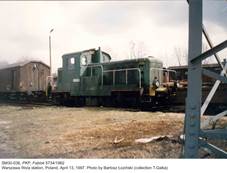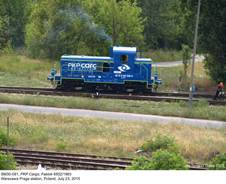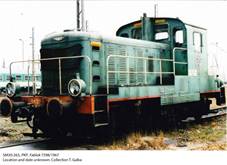SM30 / Ls300 and SP30
|
|||||||||||||||||||||||||||||||||||||||||||||||||||||||||||||||||||||||||||||||||||||||||||||||||||||||||||||||||||||||||||||||||||||||||||||||||||||||||||||||||||||||||
|
This SM30-691 was photographed at the basalt
quarry in Sulików on SM30-302 at the Toruń
Kluczyki loco depot; photo taken on Derelict SM30-002, photographed at the Ełk depot on SM30-1060 (Fablok 7878/1970) under
restoration at the Railway and Industry
Museum in Jaworzyna Śląska;
photo taken on Operational Ls300-5/948, formerly used
by Batory
steel works of Chorzów, now at the railway stock
heritage park in Pyskowice; photo taken on Withdrawn SM30-073, photographed at the Ostrołęka loco depot on SP30-006, displayed at the Kościerzyna railway stock heritage park; photo taken in August 2001. Another photo of this locomotive, taken on September 23, 2013.
Second preserved SP30-218, photographed at the Skierniewice depot on September 17, 2006.
SM30-039 preserved at the Zduńska Wola Karsznice depot, October 26, 2005. This SM30-165, photographed at the same location on August 13, 2008, still remains in service.
SM30 side drawing by M.Cwikła
(SK vol.2/2000) Two SM30s at the Małaszewicze
depot, probably still in use: SM30-053... ...and SM30-275; both photos taken on July 2,
2006. SM30-009, location and date unknown. Photo
from my collection. SM30-244, PKP,
Czerwieńsk depot, April 27, 2007. This SM30-836, photographed in Rogów on May 19, 2007, probably belongs to a track
maintenance company. Two SM30s, photographed at the Gdynia Grabówek depot on August 23, 2007: SM30-144... ...and SM30-250. Relatively few SM30s still remain in the PKP inventory. This SM30-036 was
spotted near the Warszawa Żerań station on May 28,
2008. Ls300-823, Konin
lignite mine; photo taken at the mining railway depot in Kleczew
on September 16, 2008. SM30-086, photographed at the Jelenia Góra depot on November 29, 2008. SM30-892 (probably withdrawn), photographed
in Racibórz on April 27, 2009. This Ls300 (Fablok
7832/1969) has been plinthed at the Tychy
Brewery – a place dear to my heart. Photo taken on April 30, 2009. Back to Pyskowice:
Ls300-774, photographed on May 2, 2009. SM30-292, location and date unknown. Photo by
H.Magoń (postcard from my collection). SM30-179 (Fablok
6959/1965) with a passenger train in Zbąszynek, Augst 9, 1994. Photo by Waldemar
Michniuk via Norbert Tkaczyk (used by permission). Two SM30s from the Adamów
lignite mine fleet: SM30-644 (Fablok
6609/1964)… …and SM30-694 (Fablok
6719/1964), photographed at the mining railway depot on September 20, 2011. Two pictures taken by Michał
Korfel (from my collection): SM30-189, Kielce,
January 29, 2009… …and SM30-105, location and date unknown. SM30-010 (Fablok
3540/1960), photographed in Rybnik in 1990. Photo from my collection. This
locomotive was withdrawn in July 1997 and scrapped. SP30-109 (Fablok
6520/1964), photographed in Kłodzko on May 1, 1991,
probably with a track maintenance train. Photo by M.Plewka
(from my collection). SM30-174 (Fablok
6954/1965), photographed near Maksymilianowo on
October 6, 2003. Photo by Zenon Maternowski (from
my collection). Once rebuilt into a SP30 and then converted back to the
original version, this locomotive still remains in use. SP30-188, photographed at the Kamieniec Ząbkowicki depot on
April 24, 1994. Photo by M.Zaworski (from my
collection). SM30-1000, photographed in Sochaczew on June 25, 2000. Photo by Bartosz
Łoziński (from my collection). Anolther picture taken by this author: SM30-036, Warszawa Wola
station, April 13, 1997. This locomotive still remains in use with PKP Cargo. SM30-176, photographed in Lublin on November
22, 1997 (author unknown). This locomotive is also still in use. SM30-091 (Fablok 6502/1963), still in use
with PKP Cargo. Warszawa Praga freight station, July 23, 2015. SP30-102 (Fablok 6513/1963), rebuilt in
1974, photographed at the Kraków Prokocim depot on October 10, 1997. Photo by Marek Niemiec (from my collection). This locomotive was
withdrawn in 1998. SM30-531, photographed at the Industry and Railway Museum in Jaworzyna Śląska on May 25,
2016. SM30-07, PKP
(Fablok
3536/1960), photographed probably in Poznań, date
unknown. The banner reads: ‘On April 16 we vote on the FJN list’. In fact in
those times it was not possible to vote for any list other than that of the FJN (National Unity Front).
SM30-07 was later fitted with heating boiler and became SP30-07. Photo from
my collection. SM30-211 (Fablok 6991/1965) in almost
pristine condition despite its 52 years of age; Chabówka,
Poland, May 6, 2017. SM30-248, PKP
(Fablok
7292/1966), location and date unknown. This locomotive was converted into
SP30 in 1975 and back into SM30 in 2000; in August 2021 it was withdrawn and
sold for scrap. Photo from my collection. SM30-263 (Fablok 7398/1967), location and
date unknown. This locomotive still remains the property of PKP Cargo Service. Photo from my
collection. |
First post-war diesel
locomotive, developed in Poland, was Ls40, built by Pierwsza
Fabryka Lokomotyw w Polsce (First
Locomotive Factory in Poland) of Chrzanów,
commonly known as Fablok, in 1952. This
machine, based on pre-war German Deutz OMZ 122, was a light switcher fitted with 40 hp diesel engine, mechanical transmission and mechanical
brakes. It was built mainly for various minor industrial establishments,
which had their own sidings; only nine examples were used by PKP as
class SM02, but they were suitable only for service duties. Certainly more
powerful switcher was necessary, not only for PKP, but also for many
industrial operators, for which tractive effort of just three tonnes, provided by the Ls40, was far too low. Mechanical
transmission was considered suitable for light machines only, while hydraulic
one was out of question, as torque converters were not manufactured in
Poland. Thus, for the first time in Polish locomotive industry, electric
transmission was chosen. Design of such locomotive, designated 1D, was
prepared by the Central Design Bureau of the Railway Stock Industry (CBK
PTK) between 1954 and 1955. Production was entrusted to Fablok and prototype, with factory designation
Ls300, was rolled out in 1956. According to the article by Zbigniew Tucholski (see
References), it was assigned serial number 4700/1956 – in fact the same
serial was assigned to a 1U fireless locomotive! In PKP service, this machine was
initially classed LWe55; on July 1, 1959, with new relevant national standard
introduced, it was re-classed SM30. By necessity, SM30 – in fact first indigenous diesel
locomotive suitable for line service, albeit only with light drafts – was a
simple and straightforward design, deliberately making use of as many
off-the-shelf components as possible. Thus, Wola
V Roka-300 engine was a modification of the power unit used in military
vehicles and light vessels, 600 V DC generator was developed from a
stationary unit and LT-31 traction
engines were of the type used in streetcars. Such policy could not contribute
either to high performance or to economy, but these factors were then of
minor importance. Production lasted until 1970 (some sources give 1969) and
totaled 293 examples for PKP, all given consecutive service numbers.
More SM30s were built for various industrial operators (a total of 616 is
quoted in most references, which gives a grand total of 909 machines). PKP
acquired several SM30s from industry (various sources give nine to thirteen),
which has caused some confusion concerning total output. Industrial operators
had no uniform designation system, so their engines were designated as either
SM30 or Ls300 plus service number (from 501 onwards, to distinguish from PKP
machines, sometimes corresponding to serial, but this was not the rule).
Between 1959 and 1970 seven Ls300s were purchased by armed forces (military
class WP-07); at least one of them still remains in use. Some locomotives of
this type (both from PKP and
industry) went to various private operators, who had about 25 examples in
mid-2014 (possibly not all operational). According to www.kolejowaklatka.org, at the same
time PKP had 44 SM30s, the oldest
of them being SM30-017 (Fablok 3662/1960). Most important modifications introduced during the
production run concerned the power plant: V Roka-300 engine was in later
examples replaced by its improved derivative 2DVSa-350, up-rated to 350 hp.
In the 1980s, during overhauls, many locomotives of this type were fitted
with license-built Henschel 16H12A units.
LT-31 traction engines were later supplanted by more modern LKAa-310 units.
Other modifications concerned mainly minor items of equipment. First
production SM30s could be externally distinguished by rectangular side
handrails, which were later modified and given more complex shape. SM30 was primarily intended for switching, but it
was also sometimes used with local passenger trains, often hauling one, two
or three light two-axle passenger cars. Tendency to eliminate steam
locomotives from such service resulted in an attempt to produce a passenger
derivative of SM30, fitted with an electric car heating device. Low-voltage
(500 V) system, fed from main generator, was chosen and first conversion of
SM30-232 was completed in late 1970. Tests were considered satisfactory, but
first ‘production’ machines – all converted from SM30s – appeared only in
1974. To distinguish them from standard version, they were re-classed SP30 (P
for ‘passenger’), service numbers remaining unchanged. Actual number of
converted machines is difficult to estimate. LSSP gives 106 (excluding
the prototype conversion), delivered between 1974 and 1977, many other
sources give 109, while detailed rosters available at www.kolej.pl/~jareks list 115
examples. In service it soon turned out that at low speed, typical for many
local lines, generator yielded only 200 to 400 V and heating was very
inefficient. Comparatively few cars were also fitted with low-voltage heating
systems, while special two-axle 94A cars were not successful, only 42
examples being supplied to PKP between 1976 and 1977. Thus obsolete
steam heating systems (with heating cars) remained in use and most SP30s were
in fact used as plain switchers. Last passenger cars with 500 V heating
systems survived until late 1980s. On June 1, 2000, all forty-six SP30s
remaining in service were re-classed SM30 (again retaining their service
numbers) and heating devices were removed from those that still had them. One
example of this class, SP30-006, is displayed at the former locomotive depot
in Kościerzyna. Another one, SP30-218, was
transferred in December 2005 from Łódź Olechów depot to Skierniewice,
to become a part of the PSMK railway fan society collection. There are
even plans to restore it to the operational status. Both preserved SP30s had
probably been withdrawn before June 2000 and thus were not re-classed. It was intended to supplant SM30 with more modern
SM25 with hydraulic transmission, but only three examples were built in early
1960s. Ultimate replacement materialized in 1968 as 401Da – three-axle
switcher fitted with 350 hp Henschel
diesel, which was later produced in quantity and supplied to industrial
operators only. In late 1990s PKP intended to keep about a hundred
SM30 and SP30s in service for local trains (often comprising one or two
passenger cars), as a more economical alternative to 800 hp
SM42s, but these plans never materialized. According to SK, on January
1, 1999, PKP had 63 SM30s and 33 SP30s. AL lists 79 examples in the PKP inventory five years
later, probably not all of them serviceable. Despite their obsolescence, many
more SM30s are still used by industrial establishments. A few machines have
already found their way to museums, railway stock heritage parks and
collections maintained by railway fans. Main
technical data – SM30
1)
Later examples had 2DVSa-350 257 kW / 350 hp engines, modernized machines – Henschel
16H12A 2)
Later LKAa-310 Main
technical data – SP30
1)
Service numbers unchanged. 1)
LSSP gives 107, rosters quoted
in SK give 109 examples, those
available at www.kolej.pl/~jareks –
115. References and acknowledgments
-
LSPP, AL; -
Article
on the SP30 conversion by Paweł Terczyński
(SK vol. 2/2002); -
Article
on the SM30 prototype by Zbigniew Tucholski (SK
vol. 12/2017); -
www.kolej.pl/~jareks
(Jarek Stawarz aka
Chester) – unfortunately this link is currently dead; -
www.kolejowaklatka.org (website
by Marek Dąbrowski).
|
||||||||||||||||||||||||||||||||||||||||||||||||||||||||||||||||||||||||||||||||||||||||||||||||||||||||||||||||||||||||||||||||||||||||||||||||||||||||||||||||||||||||












































